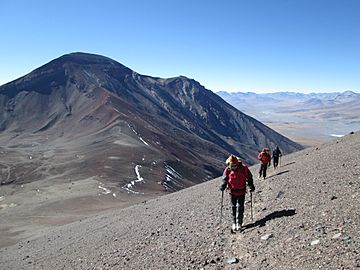San Pablo (volcano) facts for kids
Quick facts for kids San Pablo |
|
|---|---|

Volcan San Pablo from just below the summit on San Pedro volcano
|
|
| Highest point | |
| Elevation | 6,110 m (20,050 ft) |
| Prominence | 808 m (2,651 ft) |
| Parent peak | San Pedro |
| Geography | |
| Location | Chile |
| Parent range | Andes |
| Geology | |
| Mountain type | Stratovolcano |
| Climbing | |
| First ascent | September 1910 by Hans Berger (Germany) |
| Easiest route | North side to col then West slopes |
San Pablo is a volcano in Chile, close to the border with Bolivia. It is found in the Antofagasta Region. This volcano is considered dormant, which means it is currently quiet but could erupt again in the future.
San Pablo is connected to another volcano, San Pedro, by a high ridge of land. It is located in the El Loa province of Chile, near the cities of Calama and Ollagüe.
How San Pablo Formed
San Pablo was active a very long time ago, before the last ice age. After the ice age, large glaciers helped shape the mountain. They left behind piles of rock and dirt called moraines around its base.
Later, ash from the nearby San Pedro volcano covered San Pablo. The main crater of San Pablo was worn away by natural forces. A glacier even formed inside its crater.
The volcano itself is made up of three main types of hardened lava, called andesite lavas. These lavas contain different minerals like pyroxene or hornblende. Scientists group these lavas into the Lower Group, the Middle Group, and the Summit Group, based on when they formed.
First People to Climb San Pablo
The first known climb to the top of San Pablo was in September 1910. A German climber named Hans Berger was the first to reach its summit.
How Tall is San Pablo?
San Pablo officially stands at 6,050 meters (about 19,850 feet) tall. Other measurements from different mapping technologies show slightly different heights. For example, one system called SRTM measured it at 6,098 meters. Another, ASTER, measured it at 6,076 meters. And TanDEM-X measured it at 6,143 meters.
-
San Pedro volcano on the left and San Pablo volcano on the right
See also
 In Spanish: Volcán San Pablo para niños
In Spanish: Volcán San Pablo para niños



